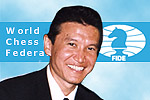| Handbook | C. General Rules and
Recommendations for Tournaments | 07. Restricted Drawing of Lots
07. Restricted Drawing of Lots
|
Approved by the 1987 General Assembly
Introduction:
In certain cases, regulations state that the drawing of lots should be carried
out in such a way that players of the same federation do not meet in the last
three rounds, if possible.
This may be done by using the Varma tables, reproduced below,
which can be modified for tournaments of from 10 to 24 players.
Directions for "restricted" drawing of tournament numbers
|
| 1. |
In the case of 19 or 20 participants, the players of the same
group (A, B, C or D) as indicated below, will not meet in the last three rounds:
- (6, 7, 8, 9, 15, 16, 17, 18)
- (1, 2, 3, 11, 12, 13, 14)
- (5, 10, 19)
- (4, 20)
The arbiter shall prepare beforehand, unmarked envelopes each
containing one of the above numbers. The envelopes containing a group of numbers
are then placed in unmarked larger envelopes. |
| 2. |
The order in which players draw lots is listed beforehand as
follows: The players of the federation with the most number of representatives
shall draw first. Where two or more federations have the same number of
representatives, precedence is determined by the alphabetical order of the FIDE
country code. Among players of the same federation, precedence is determined by
the alphabetical order of their names. |
| 3. |
For example, the first player of the first contingent with the
largest number of players shall choose one of the large envelopes containing at
least enough numbers for his contingent, and then draw one of the numbers from
this envelope. The other players from the same contingent shall also draw their
numbers from the same envelope. The numbers that remain are available for use by
other players. |
| 4. |
The players of the next contingent then draw lots and the
procedure is followed until all players have drawn their numbers. |
| 5. |
The following Varma Tables can be used for 10 to 20 players.
9/10 players
- (3, 4, 8);
- (5, 7, 9);
- (1, 6);
- (2, 10)
11/12 players
- (4, 5, 9, 10);
- (1, 2, 7);
- (6, 8, 12);
- (3, 11)
13/14 players
- (4, 5, 6, 11, 12);
- (1, 2, 8, 9);
- (7, 10, 13);
- (3, 14)
15/16 players
- (5, 6, 7, 12, 13, 14);
- (1, 2, 3, 9, 10);
- (8, 11, 15);
- (4, 16)
17/18 players
- (5, 6, 7, 8, 14, 15, 16);
- (1, 2, 3, 10, 11, 12);
- (9, 13, 17);
- (4, 18)
19/20 players
- (6, 7, 8, 9, 15, 16, 17, 18);
- (1, 2, 3, 11, 12, 13, 14);
- (5, 10, 19);
- 4, 20)
21/22 players
- (6, 7, 8, 9, 10, 17, 18, 19, 20);
- (1, 2, 3, 4, 12, 13, 14, 15);
- (11, 16, 21);
- (5, 22)
23/24 players
- (6, 7, 8, 9, 10, 11, 19, 20, 21, 22);
- (1, 2, 3, 4, 13, 14, 15, 16, 17);
- (12, 18, 23);
- (5, 24)
| |
|


